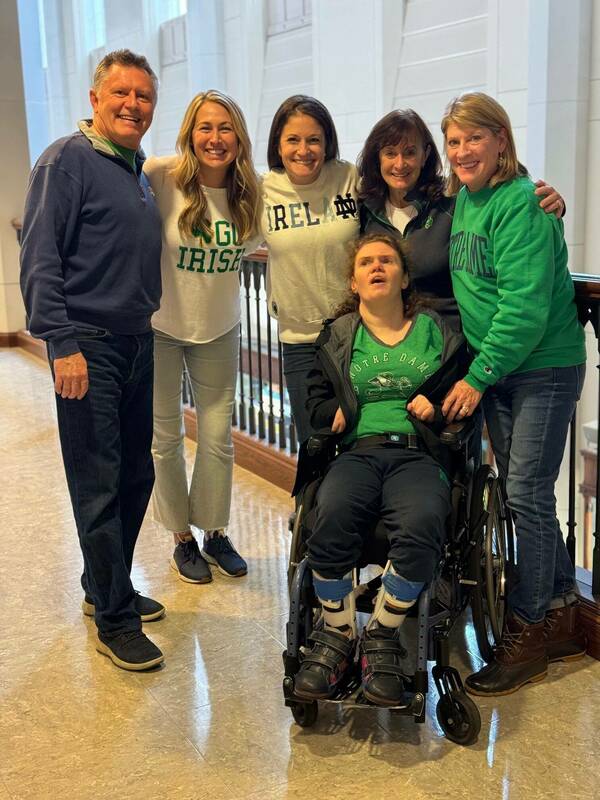Rare diseases are ones for which fewer than 200,000 people across the United States have at any given time — but they’re

certainly not “rare” for the people affected.
That’s why Dave and Cathleen Reisenauer, who have two children with a disease considered to be rare, were the first to help establish the University of Notre Dame College of Science Rare Disease Patient Advocacy Initiative by funding the Reisenauer Family Directorship for Patient Advocacy Education and Outreach. Barbara Calhoun, NP is the inaugural director for the initiative, which launched in 2022, and is the director of the minor in science and patient advocacy.
The patient advocacy initiative grew out of the Boler-Parseghian Center for Rare and Neglected Diseases, but the family began assisting Notre Dame with resources for rare disease research in 2017 when they sought help for research into Glycogen Storage Disease Type III (GSDIII).
“But we need younger people to understand more about rare diseases, and not just one rare disease,” said Cathleen Reisenauer, suggesting that Notre Dame will become a model for other institutions.
Two of the Reisenauers’ children, Peter, 34, and Cayla, 32, have the genetic disorder. The disease is caused by a buildup of a complex sugar, glycogen, in the body’s cells. Patients may have weak muscles and poor muscle tone, and could have a weakened heart. Their other son, Andrew, 26, carries the gene but does not have GSDIII.
The Reisenauers, who live in Morgan Hill, California, realized something was wrong with Peter before he was seven months old. Their pediatrician thankfully agreed to order blood tests.
The results alarmed him.
“He said, I’ve only seen this one day in medical school,” Cathleen said, describing how the pediatrician told her that he suspected GSDIII. “He’s an amazing pediatrician, because I don’t think anyone else could have diagnosed this.”
The doctor told her to rush to the hospital at Stanford Medicine to have Peter admitted immediately. That’s where he started on a zero-sugar, restrictive diet.
During her second pregnancy, Cathleen had an amniocentesis administered, which indicated their daughter, Cayla, did not have GSDIII. Unfortunately the Reisenauers noticed symptoms before she was four months old. Cayla was diagnosed about a month later, after suffering a hypoglycemic seizure.
The primary way to manage the disease in children is to provide frequent, small meals high in protein and supplemented with cornstarch, which breaks down slowly into simple sugars in the body. Unfortunately this means feedings every 30 minutes and through the night, even when they are infants.
The couple described the sleepless nights and their regular schedule dedicated to feeding their two children, both of whom had nasogastric (NG) tubes implanted from their nostrils directly into their stomachs. In spite of the dietary restrictions, Peter has thrived. A 2011 graduate of Notre Dame who went on to the University of Southern California Gould School of Law, he is a corporate lawyer in California. (Andrew also graduated from Notre Dame, in 2019, and from University of California-Los Angeles School of Law.)
Cayla was not as fortunate.
Her feeding tube became disconnected overnight when she was 3 ½ years old, causing permanent brain damage and leading to a coma that would last six weeks. She was legally blind when she came out of the coma, Cathleen said, but over the years Cayla has slowly regained vision and function.
She would have seizures from sounds and changes in her environment— the family learned to shut off the microwave with one second to go, so that it wouldn’t beep and cause a seizure. A rabid sports fan, Dave noted that even the squeaking basketball shoes on the courts, heard through the television, would set off a seizure.
“But she’s been slowly recovering all of her life,” Cathleen said, noting how diligently the family has worked with doctors to find natural treatments that will promote as much healing as possible.
Unfortunately, once the children became adults, doctors no longer wanted to treat their condition and asked the Reisenauers to find another specialist. However, as Cathleen noted, there are too few physicians with training in rare diseases to help. It’s one reason they started reaching out to universities and researchers to help.
“Cathleen and Dave have been incredibly generous,” said Santiago Schnell, the William K. Warren Foundation Dean of the College of Science. “Not only are they illuminating the issues surrounding the diagnosis of and the care for people with rare diseases, but they are encouraging our students and researchers to do the same.”
“We are grateful and are so appreciative that they are helping our efforts to bring awareness to the problems associated with diagnosis and therapies.”
The Reisenauers, both of whom graduated from Gonzaga University, have been impressed with Calhoun and students at Notre Dame, and felt an even closer connection after meeting with several during a rare disease summit at Notre Dame before the October 2023 football game against University of Southern California.
Not only did they joke that Calhoun needs to be “cloned,” they said they feel the program will only strengthen as time goes on, bringing important awareness to the issue of rare diseases.
“The next generation, and the next generation, and the next generation of students will make sure that just as “non-rare” diseases get focused on, there will be advocacy for people who are dealing with a diagnosis of a rare disease,” Dave said. “We want them to get care all through their lives, and want their caregivers to receive the support they need.
“We hope that this program at Notre Dame helps students in the minor be lifelong advocates for those with rare diseases and those that love and care for them."
Originally published by at science.nd.edu on October 25, 2023.